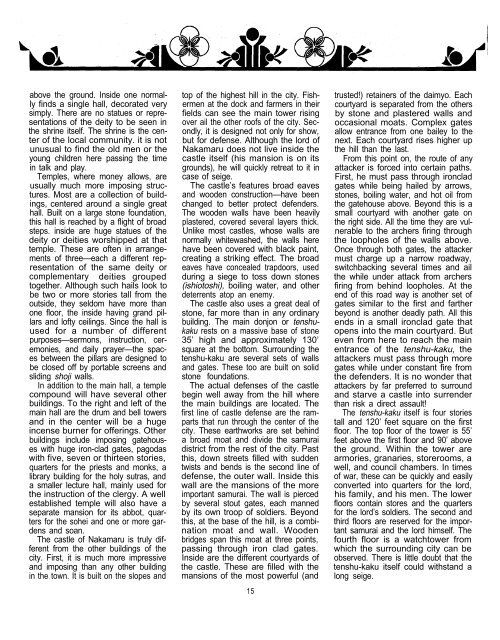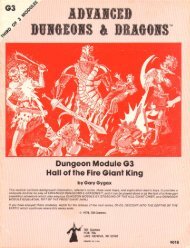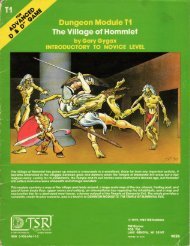Blood of the Yakuza - Free
Blood of the Yakuza - Free
Blood of the Yakuza - Free
Create successful ePaper yourself
Turn your PDF publications into a flip-book with our unique Google optimized e-Paper software.
above <strong>the</strong> ground. Inside one normally<br />
finds a single hall, decorated very<br />
simply. There are no statues or representations<br />
<strong>of</strong> <strong>the</strong> deity to be seen in<br />
<strong>the</strong> shrine itself. The shrine is <strong>the</strong> center<br />
<strong>of</strong> <strong>the</strong> local community. it is not<br />
unusual to find <strong>the</strong> old men or <strong>the</strong><br />
young children here passing <strong>the</strong> time<br />
in talk and play.<br />
Temples, where money allows, are<br />
usually much more imposing structures.<br />
Most are a collection <strong>of</strong> buildings,<br />
centered around a single great<br />
hall. Built on a large stone foundation,<br />
this hall is reached by a flight <strong>of</strong> broad<br />
steps. inside are huge statues <strong>of</strong> <strong>the</strong><br />
deity or deities worshipped at that<br />
temple. These are <strong>of</strong>ten in arrangements<br />
<strong>of</strong> three—each a different representation<br />
<strong>of</strong> <strong>the</strong> same deity or<br />
complementary deities grouped<br />
toge<strong>the</strong>r. Although such hails look to<br />
be two or more stories tall from <strong>the</strong><br />
outside, <strong>the</strong>y seldom have more than<br />
one floor, <strong>the</strong> inside having grand pillars<br />
and l<strong>of</strong>ty ceilings. Since <strong>the</strong> hall is<br />
used for a number <strong>of</strong> different<br />
purposes—sermons, instruction, ceremonies,<br />
and daily prayer—<strong>the</strong> spaces<br />
between <strong>the</strong> pillars are designed to<br />
be closed <strong>of</strong>f by portable screens and<br />
sliding shoji walls.<br />
In addition to <strong>the</strong> main hall, a temple<br />
compound will have several o<strong>the</strong>r<br />
buildings. To <strong>the</strong> right and left <strong>of</strong> <strong>the</strong><br />
main hall are <strong>the</strong> drum and bell towers<br />
and in <strong>the</strong> center will be a huge<br />
incense burner for <strong>of</strong>ferings. O<strong>the</strong>r<br />
buildings include imposing gatehouses<br />
with huge iron-clad gates, pagodas<br />
with five, seven or thirteen stories,<br />
quarters for <strong>the</strong> priests and monks, a<br />
library building for <strong>the</strong> holy sutras, and<br />
a smaller lecture hall, mainly used for<br />
<strong>the</strong> instruction <strong>of</strong> <strong>the</strong> clergy. A well<br />
established temple will also have a<br />
separate mansion for its abbot, quarters<br />
for <strong>the</strong> sohei and one or more gardens<br />
and soan.<br />
The castle <strong>of</strong> Nakamaru is truly different<br />
from <strong>the</strong> o<strong>the</strong>r buildings <strong>of</strong> <strong>the</strong><br />
city. First, it is much more impressive<br />
and imposing than any o<strong>the</strong>r building<br />
in <strong>the</strong> town. It is built on <strong>the</strong> slopes and<br />
top <strong>of</strong> <strong>the</strong> highest hill in <strong>the</strong> city. Fishermen<br />
at <strong>the</strong> dock and farmers in <strong>the</strong>ir<br />
fields can see <strong>the</strong> main tower rising<br />
over ail <strong>the</strong> o<strong>the</strong>r ro<strong>of</strong>s <strong>of</strong> <strong>the</strong> city. Secondly,<br />
it is designed not only for show,<br />
but for defense. Although <strong>the</strong> lord <strong>of</strong><br />
Nakamaru does not live inside <strong>the</strong><br />
castle itself (his mansion is on its<br />
grounds), he will quickly retreat to it in<br />
case <strong>of</strong> seige.<br />
The castle’s features broad eaves<br />
and wooden construction—have been<br />
changed to better protect defenders.<br />
The wooden walls have been heavily<br />
plastered, covered several layers thick.<br />
Unlike most castles, whose walls are<br />
normally whitewashed, <strong>the</strong> walls here<br />
have been covered with black paint,<br />
creating a striking effect. The broad<br />
eaves have concealed trapdoors, used<br />
during a siege to toss down stones<br />
(ishiotoshi), boiling water, and o<strong>the</strong>r<br />
deterrents atop an enemy.<br />
The castle also uses a great deal <strong>of</strong><br />
stone, far more than in any ordinary<br />
building. The main donjon or tenshukaku<br />
rests on a massive base <strong>of</strong> stone<br />
35’ high and approximately 130’<br />
square at <strong>the</strong> bottom. Surrounding <strong>the</strong><br />
tenshu-kaku are several sets <strong>of</strong> walls<br />
and gates. These too are built on solid<br />
stone foundations.<br />
The actual defenses <strong>of</strong> <strong>the</strong> castle<br />
begin well away from <strong>the</strong> hill where<br />
<strong>the</strong> main buildings are located. The<br />
first line <strong>of</strong> castle defense are <strong>the</strong> ramparts<br />
that run through <strong>the</strong> center <strong>of</strong> <strong>the</strong><br />
city. These earthworks are set behind<br />
a broad moat and divide <strong>the</strong> samurai<br />
district from <strong>the</strong> rest <strong>of</strong> <strong>the</strong> city. Past<br />
this, down streets filled with sudden<br />
twists and bends is <strong>the</strong> second line <strong>of</strong><br />
defense, <strong>the</strong> outer wall. Inside this<br />
wall are <strong>the</strong> mansions <strong>of</strong> <strong>the</strong> more<br />
important samurai. The wall is pierced<br />
by several stout gates, each manned<br />
by its own troop <strong>of</strong> soldiers. Beyond<br />
this, at <strong>the</strong> base <strong>of</strong> <strong>the</strong> hill, is a combination<br />
moat and wall. Wooden<br />
bridges span this moat at three points,<br />
passing through iron clad gates.<br />
Inside are <strong>the</strong> different courtyards <strong>of</strong><br />
<strong>the</strong> castle. These are filled with <strong>the</strong><br />
mansions <strong>of</strong> <strong>the</strong> most powerful (and<br />
15<br />
trusted!) retainers <strong>of</strong> <strong>the</strong> daimyo. Each<br />
courtyard is separated from <strong>the</strong> o<strong>the</strong>rs<br />
by stone and plastered walls and<br />
occasional moats. Complex gates<br />
allow entrance from one bailey to <strong>the</strong><br />
next. Each courtyard rises higher up<br />
<strong>the</strong> hill than <strong>the</strong> last.<br />
From this point on, <strong>the</strong> route <strong>of</strong> any<br />
attacker is forced into certain paths.<br />
First, he must pass through ironclad<br />
gates while being hailed by arrows,<br />
stones, boiling water, and hot oil from<br />
<strong>the</strong> gatehouse above. Beyond this is a<br />
small courtyard with ano<strong>the</strong>r gate on<br />
<strong>the</strong> right side. All <strong>the</strong> time <strong>the</strong>y are vulnerable<br />
to <strong>the</strong> archers firing through<br />
<strong>the</strong> loopholes <strong>of</strong> <strong>the</strong> walls above.<br />
Once through both gates, <strong>the</strong> attacker<br />
must charge up a narrow roadway,<br />
switchbacking several times and ail<br />
<strong>the</strong> while under attack from archers<br />
firing from behind loopholes. At <strong>the</strong><br />
end <strong>of</strong> this road way is ano<strong>the</strong>r set <strong>of</strong><br />
gates similar to <strong>the</strong> first and far<strong>the</strong>r<br />
beyond is ano<strong>the</strong>r deadly path. All this<br />
ends in a small ironclad gate that<br />
opens into <strong>the</strong> main courtyard. But<br />
even from here to reach <strong>the</strong> main<br />
entrance <strong>of</strong> <strong>the</strong> tenshu-kaku, <strong>the</strong><br />
attackers must pass through more<br />
gates while under constant fire from<br />
<strong>the</strong> defenders. It is no wonder that<br />
attackers by far preferred to surround<br />
and starve a castle into surrender<br />
than risk a direct assault!<br />
The tenshu-kaku itself is four stories<br />
tall and 120’ feet square on <strong>the</strong> first<br />
floor. The top floor <strong>of</strong> <strong>the</strong> tower is 55’<br />
feet above <strong>the</strong> first floor and 90’ above<br />
<strong>the</strong> ground. Within <strong>the</strong> tower are<br />
armories, granaries, storerooms, a<br />
well, and council chambers. In times<br />
<strong>of</strong> war, <strong>the</strong>se can be quickly and easily<br />
converted into quarters for <strong>the</strong> lord,<br />
his family, and his men. The lower<br />
floors contain stores and <strong>the</strong> quarters<br />
for <strong>the</strong> lord’s soldiers. The second and<br />
third floors are reserved for <strong>the</strong> important<br />
samurai and <strong>the</strong> lord himself. The<br />
fourth floor is a watchtower from<br />
which <strong>the</strong> surrounding city can be<br />
observed. There is little doubt that <strong>the</strong><br />
tenshu-kaku itself could withstand a<br />
long seige.
















